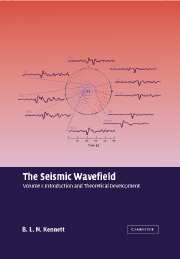4 - Seismic Sources
from PART I - SEISMIC WAVES AND THE STRUCTURE OF THE EARTH
Published online by Cambridge University Press: 07 September 2019
Summary
For a seismic wave to be recorded at a seismometer it has to be generated by the action of a source such as an earthquake or explosion. The seismic record itself bears the imprint of the propagation processes within the earth, but the patterns of Variation in the behaviour of seismic phases are to a large extent imposed by the nature of the source. As a result it is possible to infer the character of a seismic source from relatively sparse observations.
Nature of seismic sources
All sources of seismic waves involve the sudden release of some form of potential energy within the Earth or at its surface. The radiation of seismic waves is a secondary phenomenon which removes only a fraction of the original energy from the vicinity of the source.
In shallow earthquakes the stored energy is normally associated with the strain built up in a region by continuing deformation, and is usually released on a pre-existing fault System. Some major events break new rock, e.g., by linking a set of faults and a substantial amount of energy is consumed in the process. For an existing fault substantial energy is required to overcome frictional resistance leading to melting of material on the fault surface (McKenzie & Brune, 1972). Earthquakes in the shallower part of subduction zones also correspond to energy release in slippage on fault Systems, but the mode of failure in the deepest events is still not clear and may be initiated by the release of configurational energy in metastable upper mantle minerals via a phase transition.
In a explosion either chemical or nuclear energy is released in the detonation process, leading to the production of a cavity around the source point and compaction of the zone around the original Charge. In a nuclear explosion much energy is dissipated through the melting of the host rock. Surface impact sources such as a weight drop or vibrator utilise stored mechanical energy and energy is lost through surface deformation and compaction.
In the immediate neighbourhood of a seismic source, a shock wave spreads out into the medium and the stress is non-linearly related to the considerable displacements.
- Type
- Chapter
- Information
- The Seismic WavefieldVolume I: Introduction and Theoretical Development, pp. 66 - 77Publisher: Cambridge University PressPrint publication year: 2001



